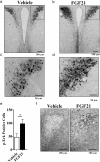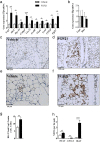Central Fibroblast Growth Factor 21 Browns White Fat via Sympathetic Action in Male Mice
- PMID: 25924103
- PMCID: PMC4475718
- DOI: 10.1210/en.2014-2001
Central Fibroblast Growth Factor 21 Browns White Fat via Sympathetic Action in Male Mice
Abstract
Fibroblast growth factor 21 (FGF21) has multiple metabolic actions, including the induction of browning in white adipose tissue. Although FGF21 stimulated browning results from a direct interaction between FGF21 and the adipocyte, browning is typically associated with activation of the sympathetic nervous system through cold exposure. We tested the hypothesis that FGF21 can act via the brain, to increase sympathetic activity and induce browning, independent of cell-autonomous actions. We administered FGF21 into the central nervous system via lateral ventricle infusion into male mice and found that the central treatment increased norepinephrine turnover in target tissues that include the inguinal white adipose tissue and brown adipose tissue. Central FGF21 stimulated browning as assessed by histology, expression of uncoupling protein 1, and the induction of gene expression associated with browning. These effects were markedly attenuated when mice were treated with a β-blocker. Additionally, neither centrally nor peripherally administered FGF21 initiated browning in mice lacking β-adrenoceptors, demonstrating that an intact adrenergic system is necessary for FGF21 action. These data indicate that FGF21 can signal in the brain to activate the sympathetic nervous system and induce adipose tissue thermogenesis.
Figures





Similar articles
-
Functional thermogenic beige adipogenesis is inducible in human neck fat.Int J Obes (Lond). 2014 Feb;38(2):170-6. doi: 10.1038/ijo.2013.82. Epub 2013 May 21. Int J Obes (Lond). 2014. PMID: 23736373 Free PMC article.
-
Pharmacologic Effects of FGF21 Are Independent of the "Browning" of White Adipose Tissue.Cell Metab. 2015 May 5;21(5):731-8. doi: 10.1016/j.cmet.2015.04.019. Cell Metab. 2015. PMID: 25955208
-
β₁-Adrenergic receptors increase UCP1 in human MADS brown adipocytes and rescue cold-acclimated β₃-adrenergic receptor-knockout mice via nonshivering thermogenesis.Am J Physiol Endocrinol Metab. 2011 Dec;301(6):E1108-18. doi: 10.1152/ajpendo.00085.2011. Epub 2011 Aug 30. Am J Physiol Endocrinol Metab. 2011. PMID: 21878665
-
Brown adipose tissue and thermogenesis.Horm Mol Biol Clin Investig. 2014 Jul;19(1):25-37. doi: 10.1515/hmbci-2014-0022. Horm Mol Biol Clin Investig. 2014. PMID: 25390014 Review.
-
UCP1 protein: The molecular hub of adipose organ plasticity.Biochimie. 2017 Mar;134:71-76. doi: 10.1016/j.biochi.2016.09.008. Epub 2016 Sep 10. Biochimie. 2017. PMID: 27622583 Review.
Cited by
-
Glucagon Regulation of Energy Expenditure.Int J Mol Sci. 2019 Oct 30;20(21):5407. doi: 10.3390/ijms20215407. Int J Mol Sci. 2019. PMID: 31671603 Free PMC article. Review.
-
Effects of Fibroblast Growth Factor 21 on Lactate Uptake and Usage in Mice with Diabetes-Associated Cognitive Decline.Mol Neurobiol. 2022 Sep;59(9):5656-5672. doi: 10.1007/s12035-022-02926-z. Epub 2022 Jun 27. Mol Neurobiol. 2022. PMID: 35761156
-
FGF21 contributes to metabolic improvements elicited by combination therapy with exenatide and pioglitazone in patients with type 2 diabetes.Am J Physiol Endocrinol Metab. 2022 Aug 1;323(2):E123-E132. doi: 10.1152/ajpendo.00050.2022. Epub 2022 Jun 20. Am J Physiol Endocrinol Metab. 2022. PMID: 35723225 Free PMC article. Clinical Trial.
-
Regulation of Energy Metabolism by Receptor Tyrosine Kinase Ligands.Front Physiol. 2020 Apr 21;11:354. doi: 10.3389/fphys.2020.00354. eCollection 2020. Front Physiol. 2020. PMID: 32372975 Free PMC article. Review.
-
Non-alcoholic steatohepatitis: emerging molecular targets and therapeutic strategies.Nat Rev Drug Discov. 2016 Apr;15(4):249-74. doi: 10.1038/nrd.2015.3. Epub 2016 Jan 22. Nat Rev Drug Discov. 2016. PMID: 26794269 Review.
References
-
- Inagaki T, Dutchak P, Zhao G, et al. Endocrine regulation of the fasting response by PPARα-mediated induction of fibroblast growth factor 21. Cell Metab. 2007;5(6):415–425. - PubMed
-
- Badman MK, Pissios P, Kennedy AR, Koukos G, Flier JS, Maratos-Flier E. Hepatic fibroblast growth factor 21 is regulated by PPARα and is a key mediator of hepatic lipid metabolism in ketotic states. Cell Metab. 2007;5(6):426–437. - PubMed
-
- De Sousa-Coelho AL, Marrero PF, Haro D. Activating transcription factor 4-dependent induction of FGF21 during amino acid deprivation. Biochem J. 2012;443(1):165–171. - PubMed
Publication types
MeSH terms
Substances
Grants and funding
LinkOut - more resources
Full Text Sources
Other Literature Sources
Research Materials

